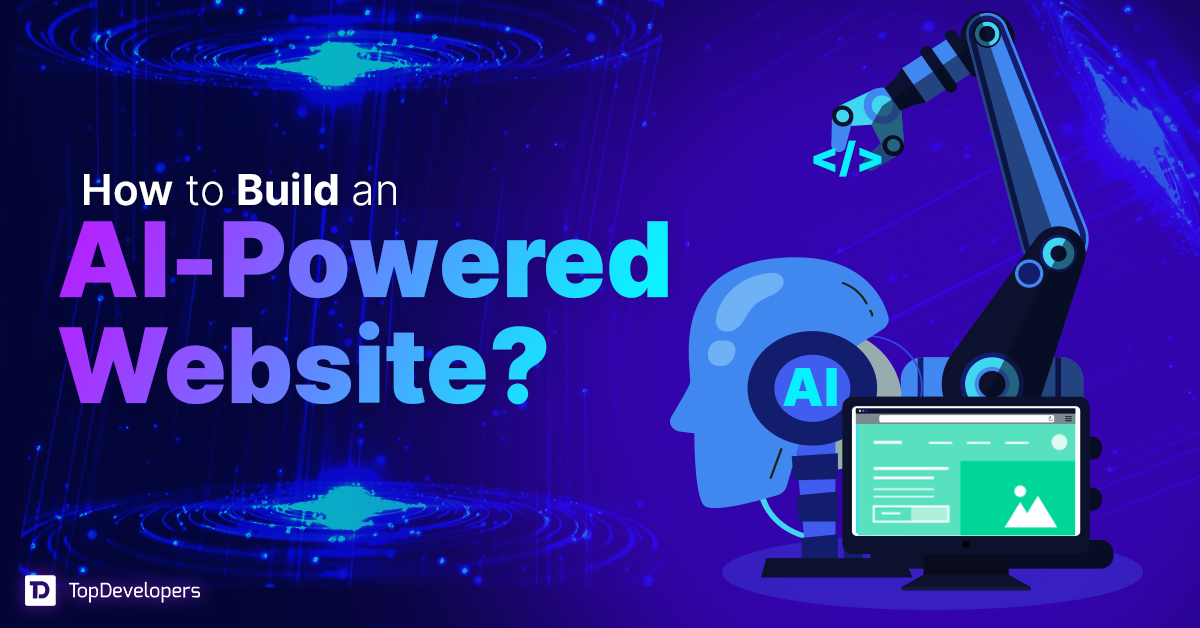
A recent report by Business Research Insights reveals that the global web development market is expected to reach USD 141.49 billion by 2033, growing at a CAGR of 8.03% from 2025 to 2033. This growing demand highlights how critical web development is for large businesses aiming to improve digital efficiency and user engagement.
Unlike standard websites, enterprise-level platforms require more than just attractive design. They must handle complex data, integrate with existing systems, and support evolving business goals. This makes enterprise web development a specialized process involving advanced planning and technical expertise.
Whether building a new platform or upgrading an old one, enterprises must consider security, performance, and scalability from day one. In this guide, explore the essential features, best practices, tools, and trends shaping enterprise web development in 2025.
Table of Contents
- What is Enterprise Web Development?
- Importance of Adhering to Best Practices in Enterprise Environments
- Key Features of Enterprise Websites
- Best Practices in Enterprise Web Development
- Tools & Technologies in Enterprise Web Development
- Industry Examples of Successful Enterprise Websites
- Challenges in Enterprise Web Development
- Future Trends in Enterprise Web Development
- Conclusion
What is Enterprise Web Development?
Enterprise web development is the process of creating robust, scalable, and secure web solutions tailored to the needs of large organizations. Unlike standard websites, these platforms are designed to handle high user traffic, integrate seamlessly with complex systems like CRMs and ERPs, and ensure compliance with industry regulations. By focusing on scalability, security, and efficiency, enterprise web development supports critical business operations and drives long-term growth.
Importance of Adhering to Best Practices in Enterprise Environments
In enterprise web development, following best practices is not just recommended—it is essential for achieving sustainable success. Best practices act as a roadmap, guiding developers to create web platforms that meet both immediate and future business needs. Here’s why adhering to these standards is critical:
- Scalability: As enterprises grow, so does the demand for their web platforms. By incorporating scalable architectures and frameworks, businesses can seamlessly handle increasing traffic and data without compromising performance.
- Security: Enterprises handle sensitive information, from customer data to financial records. Implementing advanced security measures and compliance standards minimizes the risk of breaches and builds trust with stakeholders.
- Efficiency: Best practices streamline the development process, ensuring efficient use of resources and timely delivery. They also enhance collaboration among development teams, especially in large-scale projects.
- Reliability: Comprehensive testing and adherence to coding standards ensure that enterprise web platforms remain reliable under varying conditions, fostering user confidence and satisfaction.
- Future-Proofing: The tech landscape evolves rapidly. Following industry standards prepares web platforms for easy upgrades, integrations, and adaptations to new technologies.
Ultimately, adhering to best practices allows enterprises to leverage their web platforms as powerful tools for business operations and customer engagement. By doing so, they create a foundation that not only meets current demands but is also prepared for the challenges of tomorrow.
Key Features of Enterprise Websites
Scalability
Scalable architecture is a critical feature of enterprise web development. It ensures that the platform can handle increasing data volumes, user traffic, and evolving business needs without compromising performance. A scalable web solution allows businesses to expand seamlessly, preparing for future growth.
Security
Security is paramount in enterprise website development. Implementing measures such as data encryption, secure authentication, and firewalls ensures that sensitive information is protected. Secure enterprise websites not only safeguard user data but also maintain compliance with industry regulations, building trust with customers.
Integration
Integration capabilities set enterprise web applications apart from regular websites. Seamless connectivity with CRMs, ERPs, and other tools enhances operational efficiency. By integrating these systems, businesses can streamline workflows and manage large-scale data effectively through custom enterprise websites.
Performance
High performance is non-negotiable in enterprise web development services. Optimizing load times, server response rates, and backend infrastructure ensures a seamless user experience. A large-scale website development approach focuses on reducing latency and improving speed for users across the globe.
Customization Capabilities
Enterprise-level web architecture offers extensive customization options to align with unique organizational goals. Whether it’s tailoring features or creating bespoke designs, modular web development practices enable businesses to meet specific needs while ensuring flexibility for future upgrades.
User Experience (UX)
Exceptional UX for enterprise websites is a key driver of success. Intuitive navigation, engaging interfaces, and user-friendly designs ensure customer satisfaction. A focus on UX not only retains visitors but also enhances the overall effectiveness of the enterprise website features.
Revenue Generation
An optimized enterprise website development strategy can directly impact revenue. Features like personalized user journeys, seamless e-commerce integrations, and data-driven calls-to-action help build enterprise web applications that convert visitors into loyal customers.
Improved Search Engine Optimization (SEO)
SEO optimization for enterprise sites is essential for maximizing visibility. Implementing strategies like mobile responsiveness, structured data, and keyword optimization ensures that enterprise web development best practices result in higher search engine rankings and increased organic traffic.
Best Practices in Enterprise Web Development
Enterprise web development requires a strategic approach to create platforms that meet the high standards of scalability, security, and usability demanded by large organizations. By adhering to proven best practices, businesses can ensure the reliability, efficiency, and long-term success of their enterprise websites. Below are key practices that developers should prioritize to achieve outstanding results.
Adopt Agile Methodologies
Agile methodologies facilitate iterative development, enabling teams to adapt to changing requirements and solve problems faster. By breaking down the development process into smaller, manageable cycles, Agile ensures flexibility and enhances project management. This approach promotes collaboration, ensures timely feedback, and delivers continuous improvements to the enterprise web platform.
Implement Modular Development
Modular development emphasizes the use of reusable components, which significantly enhances scalability and reduces redundancy. By building modular structures, web developers can streamline the development process, accelerate project timelines, and ensure that enterprise websites can easily adapt to future changes and expansions.
Keep Branding Consistent
Consistent branding across an enterprise website reinforces trust and credibility. By maintaining uniform visual elements, tone of voice, and functionality throughout the platform, businesses can deliver a cohesive user experience that strengthens their identity and leaves a lasting impression on visitors.
Prioritize Mobile Responsiveness
With the surge in mobile internet usage, ensuring mobile responsiveness in website is non-negotiable. Enterprise websites must offer seamless performance across all devices, from desktops to smartphones. This involves responsive design practices, adaptive layouts, and mobile-first strategies to deliver optimal experiences for users on the go.
Enforce Coding Standards and Version Control
Standardized coding practices and tools like Git ensure that development teams maintain high-quality code and foster better collaboration. Version control tools help track changes, prevent conflicts, and streamline teamwork, making the entire development process more organized and efficient.
Conduct Comprehensive Testing
Testing is critical for ensuring the reliability of an enterprise web platform. Various practices, such as unit testing, integration testing, and user acceptance testing, help identify and resolve issues before deployment. Regular testing ensures that the website functions seamlessly under different conditions, offering a dependable experience to users.
Focus on Accessibility
Designing websites that are accessible to all users, including those with disabilities, is both a legal requirement and a moral responsibility. Compliance with accessibility standards such as WCAG (Web Content Accessibility Guidelines) ensures that enterprise websites cater to a diverse audience, enhancing inclusivity and usability.
Follow Cybersecurity Best Practices
Enterprise websites handle vast amounts of sensitive data, making cybersecurity a top priority. Implementing measures such as firewalls, penetration testing, and regular security audits safeguards against potential threats. Proactive security practices build trust with users and ensure compliance with regulatory standards.
Prioritize UX
User experience is at the heart of successful enterprise websites. From intuitive navigation to visually appealing designs, every aspect of the platform should focus on delivering a seamless and engaging user journey. Enhanced UX leads to higher retention rates, improved satisfaction, and greater overall success.
Optimize for SEO
Search engine optimization (SEO) ensures that enterprise websites achieve maximum visibility. Strategies such as improving site speed, using structured data, and naturally incorporating keywords like “enterprise web development” and “enterprise web development services” help the platform rank higher and attract more organic traffic.
Tools & Technologies in Enterprise Web Development
Modern enterprise web development relies on a combination of cutting-edge tools and technologies to create robust, scalable, and efficient platforms. These tools not only streamline the development process but also ensure the website meets the complex requirements of large organizations. Here are some key categories and examples of tools and technologies used in enterprise web development:
Frameworks
Web development frameworks provide a solid foundation for building scalable and feature-rich enterprise websites. They streamline enterprise website development by offering pre-built components and structures.
- Frontend Frameworks: Angular, React, Vue.js
These frameworks enable the creation of dynamic, responsive, and interactive user interfaces.
- Backend Frameworks: Node.js, Django, Ruby on Rails
These frameworks help manage server-side logic, database interactions, and API integrations.
Content Management Systems (CMS)
Enterprise-grade CMS platforms allow organizations to manage large volumes of content efficiently while offering customization and scalability.
- WordPress: Popular for its flexibility and extensive plugin ecosystem.
- Drupal: Ideal for complex, high-traffic websites requiring robust security.
- Sitecore: A premium CMS designed for enterprise needs, focusing on personalized experiences.
APIs (Application Programming Interfaces)
APIs facilitate seamless communication between the enterprise website and other systems like CRMs, ERPs, and third-party tools.
- RESTful APIs: Widely used for their simplicity and scalability.
- GraphQL: Offers flexibility by allowing clients to request only the data they need.
- SOAP APIs: Common in legacy systems for secure and reliable data exchanges.
Version Control Systems
Version control systems are essential for managing code changes, enhancing collaboration, and maintaining a clean development history.
- Git: The most widely used version control system, ensuring seamless collaboration across teams.
- GitHub: A platform for hosting, reviewing, and managing code repositories.
- Bitbucket: Provides similar functionality with additional integration options for enterprise tools.
Testing Tools
Comprehensive website testing ensures the reliability and performance of enterprise websites across various scenarios.
- Selenium: Automates testing for web applications.
- Postman: A tool for testing APIs, ensuring data integrity and seamless communication.
- JUnit: Widely used for unit testing in Java-based enterprise projects.
Performance Optimization Tools
Enterprise websites must deliver fast load times and optimal performance to handle high-user traffic efficiently.
- Google Lighthouse: Evaluates website performance and provides actionable insights.
- Cloudflare: Enhances performance and security through CDN and DDoS protection.
- New Relic: Monitors application performance in real time.
DevOps and CI/CD Tools
DevOps tools automate deployment pipelines, ensuring smooth and frequent updates to the website.
- Jenkins: Automates build and deployment processes.
- Docker: Simplifies application deployment using containerization.
- Kubernetes: Manages containers for scalability and efficiency.
Database Technologies
Databases store and manage the vast amount of data handled by enterprise websites.
- Relational Databases: MySQL, PostgreSQL
- NoSQL Databases: MongoDB, Cassandra
These databases offer flexibility, scalability, and reliability for various data storage needs.
Industry Examples of Successful Enterprise Websites
Finance
Financial platforms require the highest levels of security and compliance to ensure the safety of sensitive transactions and personal data. Websites for major institutions like PayPal and JP Morgan Chase excel in managing secure online payments and banking services while adhering to strict regulatory standards such as PCI DSS (Payment Card Industry Data Security Standard). These platforms utilize advanced encryption protocols, multi-factor authentication, and regular audits to maintain trust and reliability.
Healthcare
Healthcare websites, such as Mayo Clinic and Epic Systems, prioritize the secure management of patient data while complying with privacy regulations like HIPAA (Health Insurance Portability and Accountability Act). These platforms integrate with electronic health record (EHR) systems, offer telemedicine capabilities, and implement stringent access controls to safeguard sensitive health information while providing seamless services to patients and healthcare providers.
E-commerce
E-commerce platforms like Amazon and Shopify demonstrate the importance of scalability and reliability in handling large-scale transactions. These websites incorporate features such as dynamic inventory management, secure payment gateways, and personalized user experiences. By leveraging advanced analytics and robust backend systems, these platforms ensure smooth operations, even during peak shopping seasons like Black Friday or Cyber Monday.
Challenges in Enterprise Web Development
Managing Complexity
Enterprise web development often involves handling intricate requirements, integrating multiple systems, and managing vast datasets. The complexity is compounded by diverse business objectives, varying stakeholder expectations, and legacy system dependencies. Addressing these challenges requires meticulous planning, robust frameworks, and clear communication among web development teams to deliver cohesive solutions.
Ensuring Security and Compliance
With ever-evolving cyber threats and stringent regulations, maintaining security and compliance is a significant challenge. Website developers must implement advanced measures like real-time threat monitoring, data encryption, and regular security audits. Additionally, adhering to international standards such as GDPR (General Data Protection Regulation) or industry-specific mandates like HIPAA adds layers of complexity.
Maintaining Performance at Scale
Enterprise websites must deliver consistent performance, even under heavy user loads or high transaction volumes. Achieving this requires scalable architectures, efficient database management, and robust content delivery networks (CDNs). Ensuring optimal speed and reliability while handling spikes in traffic is essential to maintaining user satisfaction and operational efficiency.
Coordinating Across Large Teams
Enterprise web development projects often involve multiple teams working across different locations and time zones. This diversity can lead to communication gaps, misaligned goals, and delays. Implementing project management tools, fostering transparent communication, and maintaining clear documentation are essential to coordinating efforts and achieving successful outcomes.
Future Trends in Enterprise Web Development
Adoption of AI and Machine Learning
Artificial Intelligence (AI) and Machine Learning (ML) are revolutionizing enterprise websites by introducing advanced capabilities like personalization, predictive analytics, and automation. AI-powered features, such as personalized content recommendations and dynamic user experiences, enhance engagement and retention. Predictive analytics leverages user behavior data to forecast trends and optimize decision-making, while automation streamlines repetitive tasks, improving operational efficiency. For instance, chatbots driven by natural language processing (NLP) offer real-time customer support, reducing response times and increasing satisfaction. Moreover, AI in web development plays a critical role in integrating these technologies seamlessly into modern websites.
Increased Use of Low-Code/No-Code Platforms
Low-code and no-code platforms are transforming enterprise web development by reducing dependency on traditional coding. These platforms empower non-technical users to create and manage sophisticated websites using drag-and-drop interfaces and pre-built components. By accelerating development cycles and enabling faster prototyping, these tools help businesses adapt to changing demands quickly. Examples include tools like OutSystems and Bubble, which are gaining popularity for their ability to simplify complex workflows and foster collaboration between technical and non-technical teams.
Emphasis on Progressive Web Apps (PWAs)
Progressive Web Apps (PWAs) are becoming a staple in enterprise web development for their ability to deliver app-like experiences directly through web browsers. PWAs combine the reach of websites with the functionality of native apps, offering features like offline access, push notifications, and faster load times. Companies like Twitter and Starbucks have successfully adopted PWAs to enhance user engagement and accessibility. With no need for app store downloads, PWAs provide a cost-effective and efficient alternative to traditional mobile app development.
Focus on Sustainability
As environmental concerns grow, sustainability has become a priority in enterprise web development. Companies are adopting eco-friendly practices, such as energy-efficient hosting solutions, minimizing resource-intensive coding, and using sustainable design principles. Hosting providers like GreenGeeks and AWS Sustainable Cloud offer environmentally responsible options that reduce carbon footprints. Additionally, developers are optimizing websites for performance to reduce energy consumption during user interactions, aligning their practices with broader corporate sustainability goals.
Conclusion
Best practices are the foundation of successful enterprise web development. By implementing scalable architectures, prioritizing security, and focusing on user experience, businesses can create platforms that not only meet immediate needs but also adapt to future challenges. These strategies ensure reliability, efficiency, and long-term growth, making enterprise websites powerful assets for any organization.
As the digital landscape evolves, staying updated with industry trends and embracing innovations like AI, low-code platforms, and sustainable practices is vital. Web development companies play a crucial role in guiding businesses through these advancements, ensuring they remain competitive, deliver value to users, and maintain a strong position in the market.
 Avantika Shergil
| Apr 2, 2025
Avantika Shergil
| Apr 2, 2025
Avantika Shergil is a technology enthusiast and thought leader with deep expertise in software development and web technologies. With over 8 years of experience analyzing and evaluating cutting-edge digital solutions, Avantika has a knack for demystifying complex tech trends. Her insights into modern programming frameworks, system architecture, and web innovation have empowered businesses to make informed decisions in the ever-evolving tech landscape. Avantika is passionate about bridging the gap between technology and business strategy, helping businesses build customized software and website, and understand about different tools to leverage effectively for their ventures. Explore her work for a unique perspective on the future of digital innovation.






